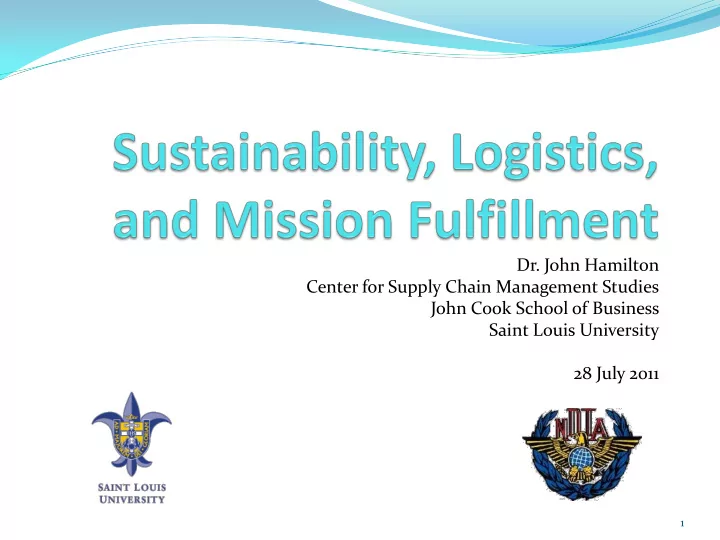

Dr. John Hamilton Center for Supply Chain Management Studies John Cook School of Business Saint Louis University 28 July 2011 1
Center Goals and Members Professional education AEP River Operations Ameren Services program development and Asynchrony Solutions delivery Anheuser-Busch, Inc. Applied research The Boeing Company Cassidy Turley Academic program support Emerson Company Energizer Holdings Company MBA - SCM concentration Monsanto Company MSc in SCM Nordyne, Inc. Novus International, Inc. Post MBA - certificate Nestle Purina Pet Care Company program Ozburn-Hessey Logistics) Sara Lee Bakery Group Solutia, Inc. Saint Louis University UniGroup, Inc. World Wide Technology USTRANSCOM (guest member) 2
Realities Sustainability defined Key drivers of sustainability Private sector What is the military doing? What can be done now? 3
Brundtland Commission – UN 1987: “Sustainable development is development that meets the needs of the present without compromising the ability of future generations to meet their own needs” A sustainable economic system is one that conserves the resources on which it depends in such a way that they will still be available to support it in the future. Sustainability is about using resources in the most efficicent manner possible. 4
A utopian environmentalist view 5
6
CHINA 7
By 2035 China’s SOL will be similar to US now Grain consumption: 2/3 of current world total production Paper consumption: 2 X world’s current total production 1.1 billion cars: nearly 4 X current US total, 40% above world current total 99 million bbl/day: current world production of 85 million Paved area equivalent to current area planted under rice 8
• $150 per barrel oil • Annual doubling of iron ore prices • Rising food prices • Water resource depletion • Maybe even climate change! 9
10
Challenges Climate change and politics Short term thinking - no instant gratification It’s all about technology / renewable energy / clean tech etc. Competition for commodities Rising world living standards 11
1. A sustainable global economy is NOT inevitable!! 2. If it happens, innovation and business will be the drivers 3. The next 10 – 20 years will see one of the biggest financial opportunities in decades 4. Competitive advantage will belong to companies that: • Build green and sustainability thinking into the very heart of their strategic thinking and planning • Consciously consider how they can contribute to the quality of life of future generations 12
13
Private sector 14
Wal-Mart Sustainability Commitment Be supplied 100% by renewable energy • Double our fleet efficiency in the U.S. by 2015 from 2005 levels • Reduce GHG emissions from existing stores, clubs and distribution centers by 20% by 2012 Create zero waste • Send zero waste to landfill in the U.S. by 2025 • Reduce global plastic shopping bag waste by an average of 33% by 2013 • 5% packaging reduction by 2013 Sell products that sustain our resources and the environment • Make the most energy intensive products 25% more efficient by 2011 • All wild-caught fresh and frozen fish for the U.S. market to be MSC certified by 2011 15
Sustainability begins with efficiency UPS has the largest private alternative-fuel fleet in the package industry — 1,819 vehicles. UPS Firsts: Electric vehicle deployed in 1935; 14 total in 2009 UPS Canada converted 764 vehicles to propane in the 1970s; 139 new in 2008; and 624 in 2009 First adopted CNG in 1985 — 1,082 CNG vehicles in 2009 First Hybrid Electric Vehicle (HEV) in 2001; 250 in 2009; expect 30 percent+ MPG over conventional diesel Our alternative-fuel Tested and deployed hybrid hydraulic vehicle in 2005; fleet has driven over expect 40 percent+ MPG 144 million miles. More than one-third of our alternative fuel/technology vehicles operate outside the U.S. (Canada, France, United Kingdom, Germany, Brazil, China and Mexico). 16
Sustainability begins with efficiency On-board wireless Telematics technology helps manage driver safety, routing and fuel efficiency. Map and review route sequence. Reduces idle time 15 min./day/driver Electronic miles per gallon (MPG) monitoring. Manages fuel-efficiency performance GPS accuracy for miles traveled. Trigger for optimal maintenance Notification before critical failure. Decreases breakdowns and inefficiencies Comprehensive maintenance. Optimizes MPG 17
Deliver competitive advantage in 3 ways • Cost savings, risk mitigation & improved operating efficiency • Superior products and services, enhanced brand image, market reputation & incremental revenue generation • Creative, innovative, productive people environment 18
What is the military doing? • USMC – lighten the load • Army Sustainability Campaign Plan • Battle Field Renewable Energy – a JF Force Enabler • DLA Sustainable Design and Development Implementation Direction • Air Force - A Guide to Sustainable Operations • FAR dated 31 May 2011 Interim Rule for Sustainability (contractors affected) 19
• Eliminate waste (lean) • Improve resource productivity (recycle / reuse) • Lower upstream and downstream costs (shorter supply chains) • Reduce package weight and materials (lower costs) 20
Thank you and any questions ? 21
Information Sources International Conference on Energy, Logistics and the Environment – Oct 2010 USMC Expeditionary Power & Energy Symposium - Jan 2010 Battlefield Renewable Energy – A key Joint Force Enabler – 2Q 2010 Army Sustainably Campaign Plan – May 2010 Air Force Guide to Sustainable Operations – May 2004 DLA Headquarters Memorandum SDD Implementation and Direction – Feb 2010 22
Recommend
More recommend